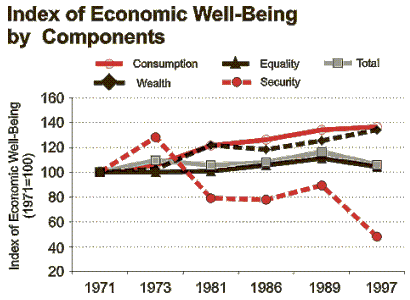
| Français | Contact Us | Help | Search | Canada Site |
| About Us | Services Where You Live | Policies & Programs | A-Z Index | Home |

Applied Research Bulletin - Volume 5, Number 1 (Summer 1999) |
|
|
|
|
Services for:
|
A New Measure of Economic Well-Being
| Contents | Next |
Overall this decade, economic well-being has declined in Canada. According to a research paper by Lars Osberg of Dalhousie University and Andrew Sharpe of the Centre for the Study of Living Standards prepared for the Applied Research Branch, well-being peaked in 1989 at about 16 percent above its 1971 level. Canadians then became gradually less well off, and by 1997 the level had fallen to only 6 percent above the 1971 mark.
Osberg and Sharpe pinpoint the main cause of this deterioration to be declining economic security—more specifically, increased risks of illness, unemployment and lone parenthood and the economic consequences associated with these situations.
The researchers develop in their paper a new measure of societal well-being named the Index of Economic Well-Being (IEWB). Some traditional economic indicators such as Gross Domestic Product (GDP) per capita show that economic well-being in Canada in the 1990s is improving, but they fail to account for non-market activities or to subtract from GDP the effect of factors such as pollution which impose costs. The IEWB does take these factors into account.
The Index of Economic Well-Being
The IEWB defines societal economic well-being as including four weighted components—consumption, wealth, equality and security. It is a comprehensive measure capturing most aspects of formal and informal economic activity. It may be used along with similar broad indicators of well-being—notably the Index of Social Health (see Applied Research Bulletin, Vol. 3, Number 2) and the Genuine Progress Index (developed at Fordham University in the United States).

"Consumption" in the IEWB is estimated using per capita market consumption, government spending and unpaid work. "Wealth" includes per capita capital stock, research and development, natural resources and human capital minus net foreign debt and the social cost of environmental degradation. "Equality" is based both on the intensity of a relative measure of poverty (Statistics Canada's Low Income Measure) and the overall distribution of after-tax income. Finally, "security" measures risk of unemployment, illness, becoming a low-income lone parent and being poor in old age.
Weighting the Elements of the MeasureSub-indexes are set so that the 1971 value equals 100. Changes from that value in a positive direction are recorded as numbers greater than 100, and those in a negative direction, as numbers less than 100. Each component of the index is assigned a weight. The weights are 0.4 for consumption, 0.1 for wealth, 0.25 for equality and 0.25 for economic security.
The various components of the IEWB behave as follows:
- Consumption index — Real consumption per capita, despite dips in the recessions of the early 1980s and the early 1990s, generally increased over the period, reaching an all-time high in 1997, 36.7 percent above its 1971 level.
- Wealth index — Driven by large gains in the value of human capital, the wealth index followed a trend similar to the consumption index. In 1997, it stood at an all-time high 34.3 percent above its 1971 level.
- Equality index — The trend was similar to that for the overall IEWB index, peaking at 11.3 percent above its 1971 level in 1989, but falling back to 4.3 percent above that level by 1997.
- Security index — By contrast to the other three components of the IEWB, the economic security component of the index declined almost continuously after 1973. It experienced a precipitous drop after 1989 to finish in 1997 at 51.8 percent below its 1971 level. It is this element that has dragged down the Index of Economic Well-Being for the 1990s.
The Economic Security Measure
The four risks selected for the economic security measure—illness, unemployment and the risk of poverty in lone parenthood and in old age—are based on the risks identified in the United Nations Universal Declaration of Human Rights. For each risk, the IEWB measures both the likelihood of facing that risk and the economic consequences of experiencing it.
The probability of losing acquired gains in the event of misfortune has increased because government fiscal restraint has reduced access to the safety nets provided by pre-paid health care and income support programs and because the risk for women of becoming a poor lone parent has increased.
On the other hand, overall economic security for Canada's older citizens has improved. The falling risk of poverty in old age and a more shallow depth of poverty for those elderly who become poor have improved economic security since 1971. The gains for the elderly have resulted from more generous real after-tax benefits from the Old Age Security and Guaranteed Income Supplement programs, wider coverage of the Canada and Quebec Pension Plans and greater access to private pension and annuity income.
Different results might be obtained with different indicators and weights chosen by other researchers. However, the findings for the Index of Economic Well-Being are consistent with those of other measures which attempt to look beyond GDP per capita as an indicator of trends in well-being.
| Contents | Next |
| Last modified : 2005-01-11 | top | Important Notices |